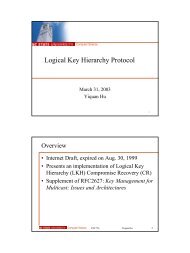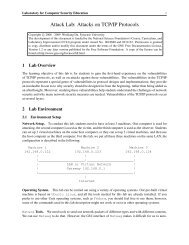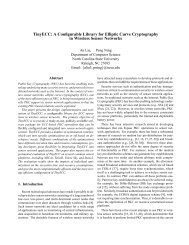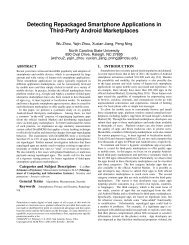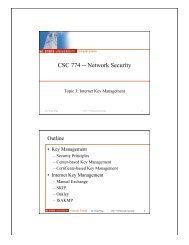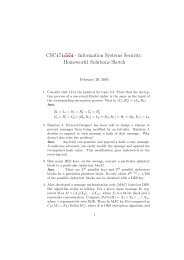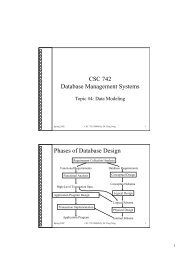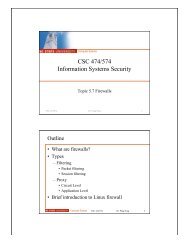Correlating Alerts Using Prerequisites of Intrusions - Dr. Peng Ning ...
Correlating Alerts Using Prerequisites of Intrusions - Dr. Peng Ning ...
Correlating Alerts Using Prerequisites of Intrusions - Dr. Peng Ning ...
You also want an ePaper? Increase the reach of your titles
YUMPU automatically turns print PDFs into web optimized ePapers that Google loves.
lowing conditions: (1) n ∈ N ′ , (2) for each n ′ ∈ N ′ other than n, there is a directed path from n ′ to n, and<br />
(3) each edge e ∈ E ′ is in a path from a node n ′ in N ′ to n. The resulting graph P G is called the precedent<br />
graph <strong>of</strong> n w.r.t. CG.<br />
Definition 9 Given a hyper-alert correlation graph CG = (N, E) and a hyper-alert n in N, subsequent<br />
(n, CG) is an operation that returns the maximum sub-graph P G = (N ′ , E ′ ) <strong>of</strong> CG that satisfies the following<br />
conditions: (1) n ∈ N ′ , (2) for each n ′ ∈ N ′ other than n, there is a directed path from n to n ′ , and (3)<br />
each edge e ∈ E ′ is in a path from n to a node n ′ in N ′ . The resulting graph P G is called the subsequent<br />
graph <strong>of</strong> n w.r.t. CG.<br />
Definition 10 Given a hyper-alert correlation graph CG = (N, E) and a hyper-alert n in N, correlated<br />
(n, CG) is an operation that returns the maximum sub-graph P G = (N ′ , E ′ ) <strong>of</strong> CG that satisfies the following<br />
conditions: (1) n ∈ N ′ , (2) for each n ′ ∈ N ′ other than n, there is either a path from n to n ′ , or a path<br />
from n ′ to n, and (3) each edge e ∈ E ′ is either in a path from a node in N ′ to n, or in a path from n to a<br />
node in N ′ . The resulting graph P G is called the correlated graph <strong>of</strong> n w.r.t. CG.<br />
Intuitively, the precedent graph <strong>of</strong> n w.r.t. CG describes all the hyper-alerts in CG that prepare for n<br />
directly or indirectly, the subsequent graph <strong>of</strong> n w.r.t. CG describes all the hyper-alerts in CG for which n<br />
prepares directly or indirectly, and the correlated graph <strong>of</strong> n w.r.t. CG includes all the hyper-alerts in CG that<br />
are correlated to n directly or indirectly. It is easy to see that correlated(n, CG) = precedent(n, CG) ∪<br />
subsequent(n, CG).<br />
Assuming the black node h SadmindBOF in figure 1(a) is the hyper-alert <strong>of</strong> concern, figures 1(b) to 1(d)<br />
display the precedent graph, subsequent graph, and correlated graph <strong>of</strong> h SadmindBOF w.r.t. the hyper-alert<br />
correlation graph in figure 1(a), respectively. Note that figure 1(d) is the same as figure 1(a). This is because<br />
all the hyper-alerts in figure 1(a) are related to h SadmindBOF via the prepare-for relation. In reality, it is<br />
certainly possible that not all hyper-alerts are related to the hyper-alert <strong>of</strong> concern. In this case the correlated<br />
graph only reveals those directly or indirectly correlated to the hyper-alert <strong>of</strong> concern.<br />
Hyper-alert correlation graph is not only an intuitive way to represent correlated attacks, but also reveals<br />
opportunities to improve intrusion detection. First, the hyper-alert correlation graph can potentially reveal<br />
the intrusion strategies behind the attacks, and thus lead to better understanding <strong>of</strong> the attacker’s intention.<br />
Second, assuming some attackers have patterns in their strategies, we can use hyper-alert correlation graph<br />
to pr<strong>of</strong>ile previous series <strong>of</strong> attacks and thus identify on-going attacks by matching to the pr<strong>of</strong>iles. A partial<br />
match to a pr<strong>of</strong>ile may indicate attacks possibly missed by the IDSs, and thus lead to human investigation<br />
and improvement <strong>of</strong> the IDSs. In addition, we may use previous hyper-alert correlation graphs to predict the<br />
next move <strong>of</strong> on-going attacks, and then take appropriate actions to prevent it from happening. Nevertheless,<br />
additional research is necessary to make these approaches possible.<br />
3.5 Advantages <strong>of</strong> Our Approach<br />
As a post-detection technique, our approach has the potential to complement the existing intrusion detection<br />
techniques. This can be seen through the following advantages <strong>of</strong> our approach.<br />
First, our approach provides a high-level representation <strong>of</strong> detected attacks that reveals the causal relationships<br />
between the alerts. Most <strong>of</strong> the current IDSs either report the detection <strong>of</strong> low-level attacks (e.g.,<br />
IP sweep, UDP port scan) as independent alerts without identifying the connection between them, or correlate<br />
the alerts using the attribute values describing the alerts (e.g., [20]). In the later case, the result <strong>of</strong> alert<br />
correlation could be misleading and unable to fully discover the causal relationships between alerts. As a<br />
result, it is difficult for the human users to figure out the logical connection between the low-level alerts and<br />
understand the logical steps or attacking strategies behind the alerts. In an extreme situation where the in-<br />
10




